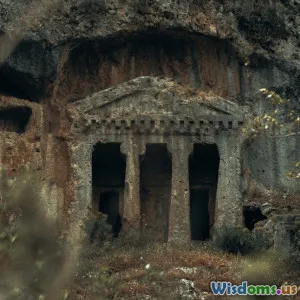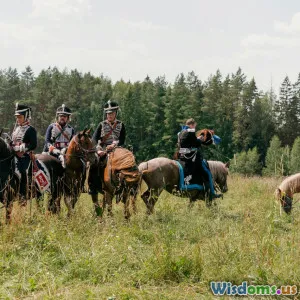
The Legacy of Forgotten Civilizations
7 min read Explore the profound influence and enduring enigmas of forgotten ancient civilizations on today’s world. (0 Reviews)
The Legacy of Forgotten Civilizations
Introduction: Unearthing History’s Silent Architects
Imagine landscapes where monumental cities once thrived but now lie silent beneath layers of sand, moss, and time. Forgotten civilizations—those that have vanished from history’s spotlight—hold keys not only to our past but also to our present and future. Their legacies stretch beyond mere ruins; they inform science, culture, architecture, and our understanding of humanity itself. This article delves into these forgotten worlds, exploring their enduring influence and the archaeological mysteries they pose.
Rediscovering Civilizations Lost to Time
The Enigmatic Indus Valley Civilization
Flourishing around 3300 BCE in what is today Pakistan and northwest India, the Indus Valley Civilization boasted a remarkably advanced urban culture. Cities like Mohenjo-Daro and Harappa featured grid layouts, sophisticated drainage systems, and standardized weights. Yet, its script remains undeciphered, speaking volumes about the lost knowledge still buried beneath modern layers.
Archaeologist Gregory Possehl emphasized the civilization’s significance: “The Indus people's meticulous urban planning can rival that of any ancient culture.” Their breakthroughs in metallurgy and trade networks hint at a complex, interconnected society previously underappreciated.
The Mysterious Olmecs: America's First Great Civilization
Often dubbed the "Mother Culture" of Mesoamerica, the Olmecs existed between 1200 and 400 BCE in present-day Mexico. Their colossal stone heads—some weighing several tons—remain marvels of craftsmanship and enigmatic symbolism. The Olmecs pioneered pyramid building, hieroglyphic writing, and possibly the earliest known calendar system in the Americas.
Dr. Michael Coe, a leading Mesoamerican scholar, remarked, “The Olmec influence is evident in nearly every culture that followed, yet much about their language and belief systems remains elusive.”
Enduring Influences and Innovations
Architectural Marvels as Cultural Testament
The far-reaching architectural imprint of forgotten civilizations is unmistakable. Take the Nabateans, who carved the city of Petra into rose-red cliffs circa 300 BCE. Petra’s advanced water management and monumental facades not only served practical needs but symbolized wealth and spiritual culture.
Similarly, the mayhem streets, temples, and pyramids constructed by the Maya civilization not only reflect religious devotion but also mathematical and astronomical precision. Their calendar famously synchronized celestial and agricultural cycles, reflecting a deep understanding of time and nature.
Knowledge Transmitted Through Artifacts and Ideas
From the Babylonian code of Hammurabi—a legal framework—to the advanced irrigation techniques of the Sumerians, the remnants of these faded societies comprise humanity’s early encyclopedias. Even culinary exchange, like the spread of quinoa from the Andes, signifies how forgotten civilizations shape global culture.
Contemporary anthropology often credits these ancient societies with seeding ideas that culminated in modern sciences. For instance, Olmec iconography likely influenced the development of Mesoamerican scripts, which later evolved into the Maya script, one of the most sophisticated writing systems of the ancient world.
Archaeological Mysteries: Puzzles Yet to be Solved
Despite significant discoveries, many questions remain unanswered. Why did the Indus Valley cities collapse abruptly? Theories range from climate change-induced droughts to invasions, but no consensus exists.
Similarly, the decline of the Maya—with once flourishing cities abandoned—has sparked debates involving overpopulation, warfare, disease, and ecological pressures. New technologies like LIDAR are revealing hidden cities beneath jungle canopies, adding pieces to this complex puzzle.
Moreover, the purpose behind Olmec colossal heads—are they depictions of rulers or deities?—continues to spark scholarly discussions. Each finding contributes to reframing history.
Lessons for Modern Civilization
The study of these forgotten civilizations offers more than historical curiosity. They underscore the impermanence of human societies and the resilience of culture. Understanding their rise and fall can inspire contemporary strategies regarding sustainability, climate adaptation, and social cohesion.
The recent resurgence of interest in indigenous agricultural practices, such as terrace farming and floodwater harvesting, demonstrates valuable lessons from ancient civilizations’ innovations in harmony with local ecosystems.
Conclusion: Keeping the Legacy Alive
Forgotten civilizations might be lost in time, but their legacies pulse within our cities, languages, and daily lives. As archaeology advances and interdisciplinary research deepens, these silent histories continue to speak. They challenge us to preserve cultural heritage and think critically about our own place in the long arc of human civilization.
The awe inspired by deciphering an ancient script or uncovering a hidden city is coupled with a humbling reminder: much of our human story still waits to be told.
“To study the past is to illuminate the future.” — Anonymous
The legacy of forgotten civilizations beckons us to listen carefully and learn, lest we too fade silently into oblivion.
References
- Possehl, Gregory. The Indus Civilization: A Contemporary Perspective. 2002.
- Coe, Michael. The Olmecs: America's First Civilization. 1968.
- LIDAR studies in Maya archaeology, Smithsonian Magazine, 2018.
- UNESCO World Heritage reports on Petra and Mohenjo-Daro.
This article aims to inspire appreciation and curiosity about ancient cultures whose echoes continue shaping our world.
Rate the Post
User Reviews
Popular Posts





















